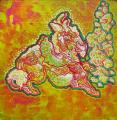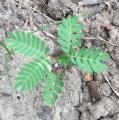
DMT-Nexus member
Posts: 1045 Joined: 12-Mar-2010 Last visit: 11-Jun-2024 Location: Urf
|
So if Morning Glory seeds have been used traditionally in Mexico and beyond, how did they prepare it? Surely not with a coffee grinder and naptha... From the unspoken
Grows the once broken
|
|
|
|
|

DMT-Nexus member
Posts: 847 Joined: 15-Aug-2020 Last visit: 17-Feb-2024
|
You never know. Coffee grinder and naphtha does the trick 😄
|
|
|

DMT-Nexus member
Posts: 1129 Joined: 12-Jul-2014 Last visit: 18-May-2024 Location: on the world in time
|
RhythmSpring wrote:So if Morning Glory seeds have been used traditionally in Mexico and beyond, how did they prepare it? Surely not with a coffee grinder and naptha... Haha The best way I’ve found is to make a tincture of green seed pods in a pint of Jose Cuervo
|
|
|

DMT-Nexus member
Posts: 385 Joined: 20-Mar-2016 Last visit: 26-Sep-2024
|
Mortar and pestle and cold water, I think.
|
|
|

DMT-Nexus member
Posts: 617 Joined: 16-May-2015 Last visit: 13-Feb-2024
|
ijahdan wrote:Mortar and pestle and cold water, I think. it seems like that yes. Quote:The convolvulaceae are a family of herbaceous ornamental plants with infundibular (bell-shaped) flowers. Different species have seeds containing different alkaloids of the LSD family, such as d-lysergic acidamide (ergine) and isoergine, which act as partial serotonergic agonists. The seeds of Turbina corymbosa (ololiuhqui) and Ipomea violacea (tlilitzin) were consumed by the Maya and Aztec for their psychotropic effects on perception and emotions and to induce trance states. They were commonly used by Mixtec and Zapotec peoples in the state of Oaxaca, and they are used to this day by the local healers who conduct 15714 Hallucinogenic drugs in the Americas 47 curative and divination ceremonies. Ololiuhqui is very common in Mexico, and it is a type of morning glory so named because its flowers close during the night to reopen in the morning. In Spanish, it is also known as quiebracajete blanco, or flor de la virgen, since it had religious connota- tions in the 16th century. T. corymbosa has round coffee coloured seeds, whereas those of Ipomea violacea are black and called badoh negro. These seeds are ground into powder and taken in water, and they induce sensory/perception alterations that include visual illusions, synaesthesia, euphoria, memory changes, and discrete somnolence. In its cultural context, in contrast with the practices associated with peyote or hallucinogenic mushroom use, ololiuhqui is most often taken alone with the healer. The first phase is marked by a psychic void, which is at times accompanied by vasovagal response and vertigo; some hours later, this is followed by a period of intense serenity and sedation. https://doi.org/10.1016/j.nrleng.2011.07.010interesting stuff here too with information on usage https://www.samorini.it/doc1/alt...e-of-rivea-corymbosa.pdf"Is this the end of our adventure? Nothing has an end. We came in search of the secret of immortality, to be like gods, and here we are... mortals, more human than ever. If we have not obtained immortality, at least we have obtained reality. We began in a fairytale and we came to life! But is this life reality? We are images, dreams, photographs. We must not stay here! Prisoners! We shall break the illusion. This is Maya. Goodbye to the holy mountain. Real life awaits us." ~ Alejandro Jodorowsky
|
|
|

Retired from Forum
Posts: 68 Joined: 16-Jul-2022 Last visit: 19-Jul-2022
|
This has been written about quite a bit in the last century.
The plants were used in different forms and in some cases leaves were reported to be used.
There were also sorcerers or shamanic seers dedicated to the plant itself, where a person seeking an answer didn't take the plant but instead consulted the seer who would take the plant and seek an answer. This type of use was common for several substances and not just the Morning Glory material.
There was documented use of ground seeds being soaked for a short time in cool water and then the material strained or sieved out and then ingested. A metate was used to grind the seeds in those cases.
Some codex material may also indicate that there were cooked preparations or decoctions combining morningglory material with other plants and or substances. The blood of a serpent does appear to be a common ingredient to some old potions containing psychoactive plants, as an example.
The plants were reportedly ingested in various form including leaf and seed to treat different ailments as well, including tumors. Even the psychoactive morning glories tend also to contain resinous chemicals that act as irritants to the intestine and one of the most common uses of morning glory was to promote defecation. In fact this use is found in Asia, Africa and the Americas and one species Merremia tuberosa or Woodrose (not Hawaiian baby Woodrose)is such a strong irritant that people who have overdosed on in it the past have literally shat themselves to death. Most morning glory species will not make you poop to death, but many of them will make you poop. In fact the intestinal discomfort they can cause is a common reported effect for people who eat seeds.
Eating the seeds whole however is not reported as a traditional way to use the psychoactive morning glory material. Cold Water Extraction is essentially the traditional method that avoids the pronounced discomfort that the purgative resins can cause.
Many morning glory species are eaten for food, like Ipomoea batatas (batatas=potatoes by the way) but also Ipomoea muricata and Ipomoea aquatica, both of which may contain some clavine and lysergic acid alkaloid content. Since the alkaloids of morning glory are made by Periglandula symbiotes any species of active morning-glory can also be inactive (if it lacks the fungus) and active and inactive forms (active=ergine alkaloid +) are known for some species. Ipomoea fistulosa even has both active and dangerously toxic forms reported for it. and it is regarded as having seen some traditional use.
In the early literature it was reported that some clones were used or preferred over others, and in one report a single plant was used for an entire village. This makes sense given the symbiote status of the plants can vary, in some cases going out and trying random plants in nature could result in death or a profound psychedelic experience and so using safe proven material also appears to be a part of the tradition of use. Modern use of Hawaiian Baby Woodrose also appears to reflect similar discrepancies.
This has been a summary of my answer to the OP question, which is an extensive topic.
|
|
|

DMT-Nexus member
Posts: 1045 Joined: 12-Mar-2010 Last visit: 11-Jun-2024 Location: Urf
|
Thank you! I had no idea the historic documentation was so in-depth. Would you mind sharing some of your sources? So cold water extraction... and also grinding up the soaked seeds and eating them, too? I like the idea of steeping them as a tea for a few hours--I've had some success with that method--and then eating the seeds, too. From the unspoken
Grows the once broken
|
|
|

Retired from Forum
Posts: 68 Joined: 16-Jul-2022 Last visit: 19-Jul-2022
|
https://erowid.org/enthe...tings/wasson_notes.shtmlhttps://erowid.org/plant...bulletin-narcotics.shtmlThese first two links have basic sections about the topic. I am attaching a PDF file on the topic as well, it a major source of a lot of the information I shared. It is specifically about Ololuihqui, but applies largely to the use of Badoh Negro (black seed) as well, which is presently identified as Ipomoea tricolor though the old literature uses the name Ipomoea violacea. Some of the traditional use literature is more focused upon the application than the substance, for example several traditional entheogens have seen use in divination for things like finding lost objects or even causing harm to an enemy. In those cases those specific practices must be studied to learn their use and or application and they cannot be learned by focusing upon the material ingested. For this reason such practices are not typically expounded upon nor studied in any real detail by ethnobotanists, but such material can be learned about from sources involved in cultural anthropology. I suggest the book Nagualism by Brinton to learn more about the context and traditions involved in the use of Morning Glory entheogens as well as others. Here is a link to that: https://archive.org/details/cu31924020427542
|
|
|

DMT-Nexus member
Posts: 1045 Joined: 12-Mar-2010 Last visit: 11-Jun-2024 Location: Urf
|
Thanks! Though I must point out: the two erowid sources you listed do not discuss morning glories. Yes, the plants are similar, but they are also different! From the unspoken
Grows the once broken
|
|
|

Retired from Forum
Posts: 68 Joined: 16-Jul-2022 Last visit: 19-Jul-2022
|
RhythmSpring wrote:Thanks!
Though I must point out: the two erowid sources you listed do not discuss morning glories. Yes, the plants are similar, but they are also different! https://erowid.org/enthe...tings/wasson_notes.shtmlQuote:Notes on the Present Status of Ololiuhqui
and the Other Hallucinogens of Mexico
R. GORDON WASSON
That Erowid source lists Ololiuhqui and Tlitliltzen, both are morning glories and both are at present taxonomically defined as Ipomoea species though older epithets are still widely used for the plant, and here is it's wikipedia page. https://en.wikipedia.org/wiki/Ipomoea_corymbosaAnd the first sentence of that page is: Quote:Ipomoea corymbosa is a species of morning glory Tlitliltzen is also listed in that work and it is now known as Ipomoea tricolor though in the old literature it is called Ipomoea violacea, another morning glory species. The other link page was titled: Quote:Teonanácatl and Ololiuqui, two ancient magic drugs of Mexico The second substance is a previously mentioned morning glory; Ipomoea corymbosa. I apologize if I have created some confusion regarding the topic. I grow over a dozen different species of Morning Glory and have seeds of nearly 2 dozen species and or forms. I am including a photo I just took of a Morning Glory native to Texas, Convolvulus equitans. 8-Serpent-Wind attached the following image(s):  Equit.jpg (52kb) downloaded 154 time(s).
|
|
|

DMT-Nexus member
Posts: 116 Joined: 31-Oct-2020 Last visit: 07-Jan-2024
|
harvested a couple thousand MG seeds today from my yard which gets overgrown by them each year. they are all brown/black, so not fresh by any means. seems like cold water extraction is the go-to method?
Can the pint of cuervo be used for a tincture on dried goods or must they be fresh? that's sort of more my style.
Also-- should I go the cold water route, must the mixture be consumed immediately or is it stable to keep longterm?
thanks!
|
|
|
DMT-Nexus member
Posts: 270 Joined: 15-Mar-2022 Last visit: 05-Jun-2025
|
pointy hat wrote:harvested a couple thousand MG seeds today from my yard which gets overgrown by them each year. they are all brown/black, so not fresh by any means. seems like cold water extraction is the go-to method?
Can the pint of cuervo be used for a tincture on dried goods or must they be fresh? that's sort of more my style.
Also-- should I go the cold water route, must the mixture be consumed immediately or is it stable to keep longterm?
thanks! What color are those flowers? Do they tend toward purple instead of blue? (look at a few since they can vary some)
|
|
|

DMT-Nexus member
Posts: 116 Joined: 31-Oct-2020 Last visit: 07-Jan-2024
|
hey bdp, they are definitely purple, not blue.
|
|
|

Boundary condition

Posts: 8617 Joined: 30-Aug-2008 Last visit: 29-Nov-2025 Location: square root of minus one
|
pointy hat wrote:hey bdp, they are definitely purple, not blue. Are the seeds elongated, or more round-ish? “There is a way of manipulating matter and energy so as to produce what modern scientists call 'a field of force'. The field acts on the observer and puts him in a privileged position vis-à-vis the universe. From this position he has access to the realities which are ordinarily hidden from us by time and space, matter and energy. This is what we call the Great Work." ― Jacques Bergier, quoting Fulcanelli
|
|
|

DMT-Nexus member
Posts: 116 Joined: 31-Oct-2020 Last visit: 07-Jan-2024
|
DFZero-- roundish, sort of like a misshapen capital D, or a fat teardrop.
there is an elongated type seed that comes from a pod similar to the MGs that grow in my yard but they belong to a type of hibiscus flower like vine
|
|
|
DMT-Nexus member
Posts: 270 Joined: 15-Mar-2022 Last visit: 05-Jun-2025
|
Those are likely Grandpa ott. They are the most common escaped Morning Glory and have purple flowers.
I haven't found much on them as to alkaloid level but what I have found seems to indicate either much less than Heavenly Blue or none. Remembering that these plants also have things which will make you nauseous in them and remembering that Heavenly Blue is pretty easy to grow, I decided not to mess with the Grandpa ott all over my yard.
|
|
|

Boundary condition

Posts: 8617 Joined: 30-Aug-2008 Last visit: 29-Nov-2025 Location: square root of minus one
|
Yep, confirms my suspicion too that they're purpureas like Grandpa Ott (funny cooincidence with that name - or is it?) Grandpa Ott's have even semi-naturalised in my garden in Northern Europe! The lovely flowers do a good job of compensating for their minimal value as a psychedelic. “There is a way of manipulating matter and energy so as to produce what modern scientists call 'a field of force'. The field acts on the observer and puts him in a privileged position vis-à-vis the universe. From this position he has access to the realities which are ordinarily hidden from us by time and space, matter and energy. This is what we call the Great Work." ― Jacques Bergier, quoting Fulcanelli
|
|
|

DMT-Nexus member
Posts: 116 Joined: 31-Oct-2020 Last visit: 07-Jan-2024
|
thanks y'all. appreciate the shared knowledge and avoided stomachache
|